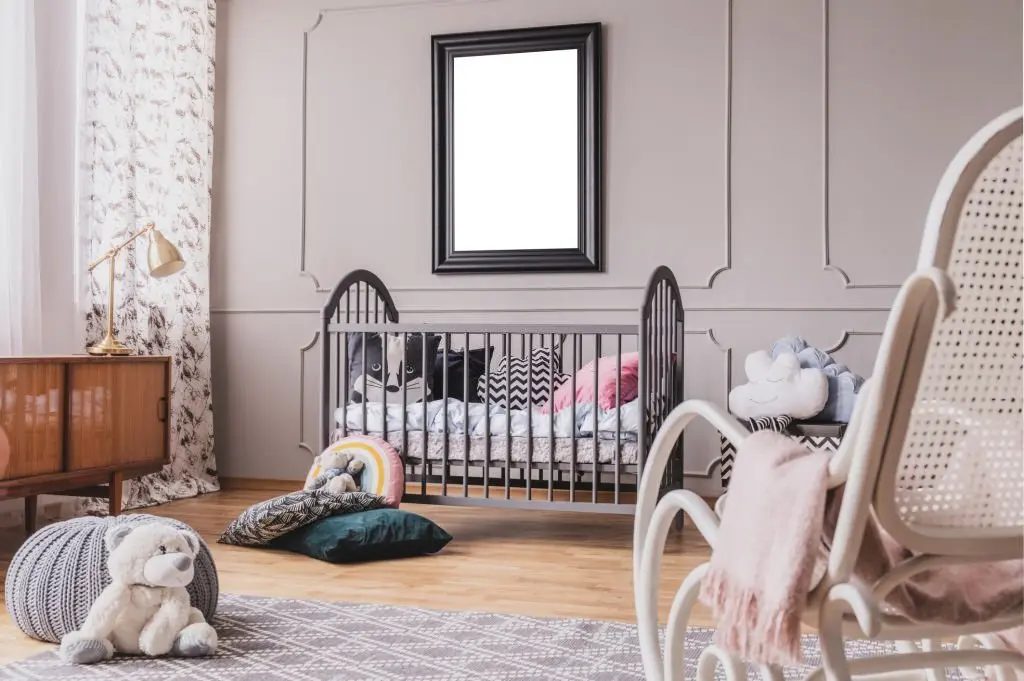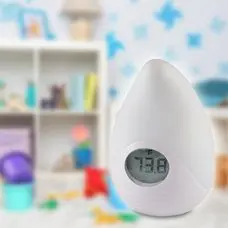What Temperature Should Baby Bursery Be: Guide

Maintaining the right temperature in the baby nursery is crucial for the comfort, safety, and overall well-being of your baby. The temperature of the nursery can have a significant impact on your baby’s sleep patterns and development. It is important to understand how temperature affects your baby and what temperature should baby nursery be to create an environment that promotes healthy sleep and growth.
The temperature in the nursery can directly affect your baby’s sleep patterns. Babies are more sensitive to temperature changes than adults, and even a slight variation in temperature can disrupt their sleep. A room that is too hot or too cold can make it difficult for your baby to fall asleep and stay asleep throughout the night.
Additionally, the temperature in the nursery can also impact your baby’s growth and development. Babies need a consistent and comfortable environment to thrive, and maintaining the right temperature is an essential part of creating that environment.
Factors to consider when determining the temperature of your baby’s room
Several factors come into play when determining the ideal temperature for a baby’s room. These include the current season, the baby’s age, and their overall health status. For instance, newborns and premature babies may require a slightly warmer room as they struggle to regulate their body temperature.
The recommended temperature for a baby nursery

According to guidelines from the American Academy of Pediatrics, the recommended room temperature for babies should be between 68-72 degrees Fahrenheit (20-22 degrees Celsius). This range provides a comfortable temperature that is neither too hot nor too cold for your little one.
Ideal room temperature for a baby’s room during different seasons
The ideal room temperature for your baby may vary slightly with changing seasons. During the summer months, it’s essential to ensure that your baby’s room is not too hot as babies can overheat easily. Conversely, in winter months, you need to make sure that your baby is not too cold by maintaining a safe room temperature.
Importance of monitoring the temperature regularly
Regularly monitoring the temperature in your baby’s room is crucial in ensuring their comfort and safety. A sudden change in temperature can disrupt your baby’s sleep and may even pose health risks.
High-temperature risks
Incorrect room temperatures can pose several health risks to babies. Overheating has been linked with an increased risk of Sudden infant death syndrome (SIDS while underheating can lead to hypothermia. Moreover, an incorrect room temperature can disrupt your baby’s sleep patterns, affecting their growth and development.
Tips for maintaining the right temperature in a baby nursery
Maintaining the right room temperature plays an essential role in keeping your baby safe and comfortable. Here are some tips:
Use a Room Thermometer: A room thermometer can help you accurately monitor the temperature in your baby’s room.
Proper Insulation and Ventilation: Ensure that your baby’s room is well-insulated during winter and adequately ventilated during summer.
Appropriate Bedding and Clothing: Dress your baby appropriately for sleep based on the current room temperature.
Avoid Direct Sunlight and Drafts: Keep blinds or curtains closed during hot days to prevent direct sunlight from overheating the room.
Be Vigilant: Regularly check if your baby feels too hot or too cold and adjust the room temperature accordingly.
The Science behind the optimal baby nursery temperature
Research and studies have been conducted to determine the optimal temperature for a baby’s nursery. These studies have found that a temperature range of 68-72 degrees Fahrenheit (20-22 degrees Celsius) is ideal for promoting healthy sleep and development. This range helps to regulate your baby’s body temperature and allows them to enter into a deep and restful sleep.
Temperature also plays a role in your baby’s body temperature regulation. Babies have a limited ability to regulate their body temperature, so it is important to provide them with a consistent environment. When the room is too hot, your baby may become overheated and struggle to cool down. Conversely, when the room is too cold, your baby may have difficulty maintaining their body temperature and may become cold.
Maintaining a consistent temperature in the nursery is crucial for your baby’s comfort and safety. Sudden changes in temperature can disrupt their sleep patterns and potentially impact their growth and development. It is important to ensure that the temperature in the nursery remains within the recommended range and make any necessary adjustments as needed.
Common mistakes to avoid when setting the nursery temperature
When it comes to setting the temperature in the nursery, there are a few common mistakes that parents often make. One of the most common mistakes is overheating the nursery. Parents may think that a warmer room will help their baby sleep better, but in reality, it can lead to discomfort and disrupt their sleep. Overheating can also increase the risk of Sudden Infant Death Syndrome (SIDS).
Another mistake is underestimating the impact of temperature on your baby’s sleep. Even a slight variation in temperature can disrupt their sleep patterns and lead to frequent waking throughout the night. It is important to create a comfortable and consistent environment for your baby to promote healthy sleep.
Lastly, some parents may ignore the importance of ventilation in the nursery. Proper ventilation helps to circulate fresh air and maintain a comfortable temperature in the room. It is important to ensure that there is adequate airflow in the nursery to prevent stuffiness and maintain a healthy environment for your baby.
Creating a comfortable and safe environment for your baby’s sleep
In addition to maintaining the right temperature, there are other factors to consider when creating a comfortable and safe environment for your baby’s sleep. Firstly, it is important to use appropriate bedding and clothing. Choose lightweight and breathable fabrics that will help regulate your baby’s body temperature and prevent overheating or chilling.
Proper ventilation is also crucial in creating a comfortable environment for your baby’s sleep. Ensure that there is adequate airflow in the nursery by opening windows or using a fan. This will help circulate fresh air and maintain a comfortable temperature in the room.
If necessary, you can also use a fan or air conditioner to regulate the temperature in the nursery. However, it is important to ensure that the fan or air conditioner is not blowing directly on your baby. Position the fan or air conditioner in a way that it circulates the air in the room without directly blowing on your baby.
The relationship between temperature and sudden Infant death syndrome
The temperature in the nursery can also affect the risk of Sudden Infant Death Syndrome (SIDS). SIDS is the sudden and unexplained death of a baby under one year of age. Research has shown that overheating can increase the risk of SIDS. Babies who are too hot may have difficulty regulating their body temperature and may be more susceptible to SIDS.
To reduce the risk of SIDS through temperature regulation, it is important to follow safe sleep guidelines. These guidelines recommend placing your baby on their back to sleep, using a firm mattress with a fitted sheet, and avoiding loose bedding or soft objects in the crib. It is also important to ensure that the room is at a comfortable temperature and not too hot.
Conclusion on what temperature should baby nursery be
Maintaining the right temperature in the baby nursery is crucial for your baby’s comfort, safety, and overall well-being. The temperature in the nursery can directly impact your baby’s sleep patterns and development. It is important to understand how temperature affects your baby and take steps to create an environment that promotes healthy sleep and growth.
To find the ideal temperature range for your baby’s nursery, it is recommended to keep the room between 68-72 degrees Fahrenheit (20-22 degrees Celsius). Factors such as the season and your baby’s individual needs should be taken into account when setting the nursery temperature. Use a thermometer to monitor the temperature and make any necessary adjustments.
Creating a comfortable and safe environment for your baby’s sleep involves more than just maintaining the right temperature. Use appropriate bedding and clothing, ensure proper ventilation in the nursery, and use a fan or air conditioner to regulate the temperature if needed. By following these tips and recommendations, you can create an optimal environment for your baby’s sleep and development.
Note: Remember that every child is unique and what works best for one might not work as well for another. Always consult with a healthcare professional if you have concerns about your child’s comfort or safety.
Also Read:
- Is It Safe to Hang Pictures Above a Crib?
- How to Make Baby More Comfortable in Crib
- Tips On How To Decorate a Nursery On a Budget
FAQs on what temperature should baby nursery be
Is 23 degrees too hot for a baby’s room?
Yes, 23 degrees Celsius (73 degrees Fahrenheit) may be slightly too warm for a baby’s room according to guidelines from the American Academy of Pediatrics.
How do I know if my room is too hot for my baby?
If your baby feels sweaty or their chest feels hot, these could be signs that they are overheating.
Does room temperature affect my baby?
Yes, both overheating and underheating can pose risks to babies including discomfort, disrupted sleep, hypothermia, or an increased risk of SIDS.
What happens if my baby is too cold at night?
If a baby gets too cold during sleep they may become restless and wake frequently. In extreme cases, being too cold can lead to hypothermia.
